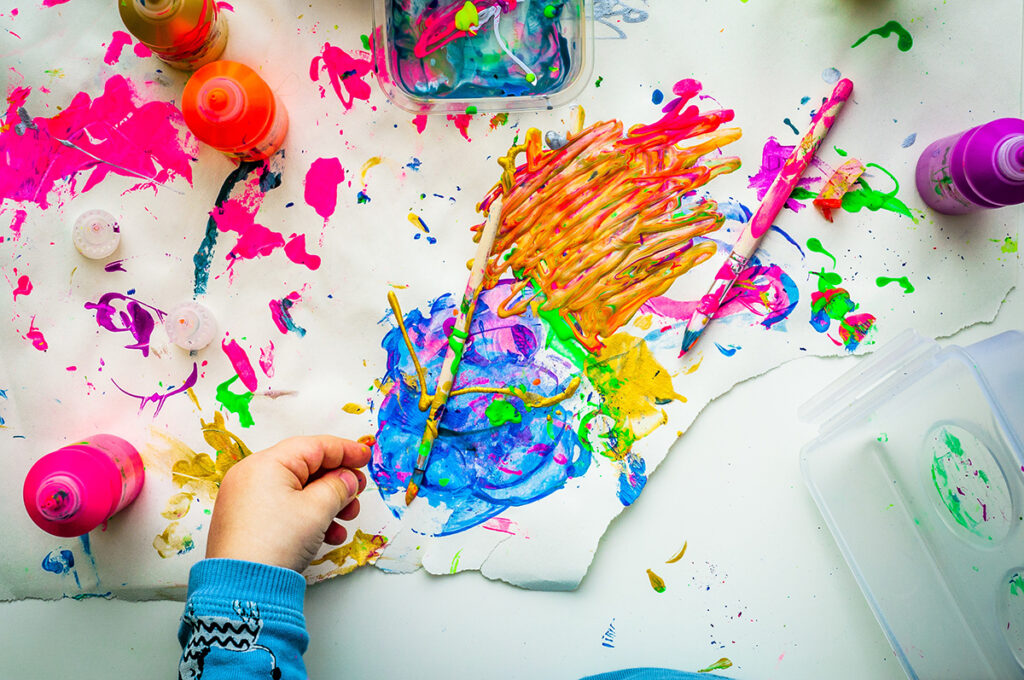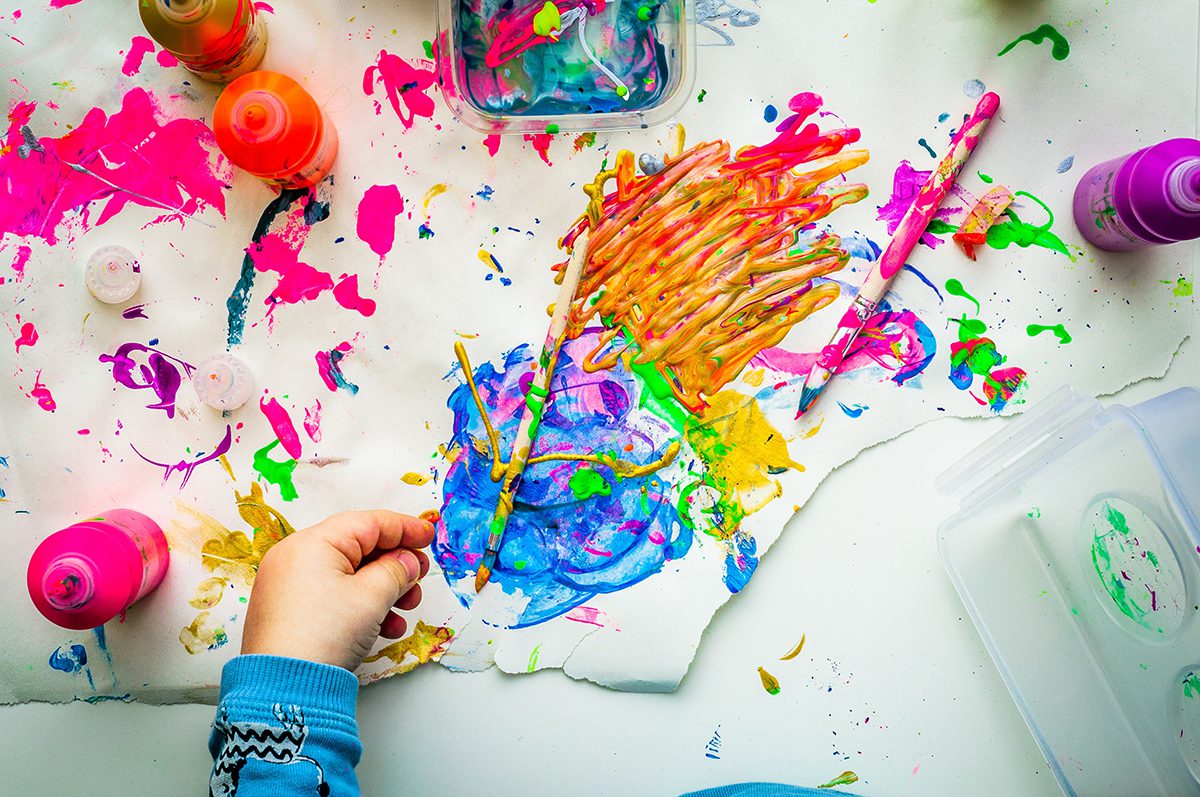Dear First-Year Art Teacher,
As we close out this crazy year, we wanted to leave you—our first-year art teachers—with a special note crafted just for you.
Becoming an art teacher during the past couple of years was quite a unique experience! You may have started your art education journey excited to get into the classroom. Instead, a pandemic hit, leading to school closures and virtual student teaching. Now, you are in the classroom with real, live students for the first time! Classroom management is a whole different ballgame when you have thirty faces staring back at you instead of empty, silent, black rectangles on a screen. Supplies are overwhelming each period with prep, distribution, cleanup, inventory, and organization. How do you even get your class to clean their paintbrushes and palettes (the right way!) before the bell rings?
Rather than quoting a textbook or peer-reviewed article on what you should do, we surveyed social media. We received a ton of tried and true advice from experienced art teachers who have been where you are. From humorous stories to sage wisdom, we are here to share ALL our tips and tricks with you.

Let’s see what these veteran teachers have to say as we equip you with resources along the way.
Before we dive right in, you may want to hear some advice from a fellow new art teacher who has just been where you are. If that is the case, let us introduce you to Brittney Witt, a middle school art teacher in Minnesota. Listen to her recently-learned advice to make the most of your first year in our mini-series, First-Year Art Teacher’s Guide. You can catch the latest episode here or swing by this page to grab your own guide!
Pursue grace over perfection.
It’s your first year! You probably started with overflowing enthusiasm to have your own classroom or cart, make everything Insta perfect, change students’ lives through art, and tackle every cool project you have ever seen on Pinterest. Perhaps the biggest theme in the pool of advice we received was to be patient, slow down, and take your time.
What?! You are probably wondering how on earth can you slow down when you have so much to do? The first step is to realize teaching is a marathon, not a sprint.
Persevere and pace yourself with the following pieces of advice:
- Perfection is overrated.
Nothing is perfect, nor will it ever be. There will always be something more you can do to make something better. While we want to continue challenging ourselves, we also need to make sure we are doing so at a sustainable rate. Andrea Tabor affirms that “your lessons do NOT need to be perfect,” and Abby Webb recommends “developing one good lesson for each class you teach and then just get by with the other lessons. As time goes by, you will eventually have a whole year of really great lessons.” - You are new, not an expert.
You are a first-year teacher, which means you are doing something for the first time. Theodora Thompson shares that you don’t know everything, you won’t know everything, and you’re not supposed to know everything. You are not an expert, and no one expects you to be. - Failure is okay.
Everyone fails and makes mistakes—even us veteran teachers! It’s inevitable and a part of life. Kelly Beach tells us to “Learn from it and move on.” Or, in the wise words of Maya Angelou, shared by Tony Barnack, “Do the best you can until you know better. Then when you know better, do better.” Lauralee Chambers reminds, “Let them see your flexibility, mistakes, authenticity.” - Fake it ‘til you make it!
It is also not a long-term solution to go full throttle. Michael Catalano says, “You can’t do everything at 1000%. Prioritize the kids and your lessons! Everything else, fake it ‘til you make it!” - Process over product.
Just like with your students’ artmaking, there is value in looking at your teaching journey through a “process over product” lens. Carol T. said she learned that doing fewer projects was much better for everyone. - Community over comparison.
It’s easy to get caught up in every other art teacher’s amazing highlight reel on social media. But don’t. With the nature of our jobs, Lynn Volker says to not “… compare yourself to other teachers. Expect chaos and mess.”

Put relationships first.
Not all of your students are going to love art as much as you do—and that’s alright. The best way to motivate your students is to build rapport. If they like you and see that you care, they will be more likely to behave and put forth effort for you. Plus, getting to know students is just plain fun! As Paula Harrington states, “Love them and they’ll love you! Everything else is details.”
Here are some reminders as you invest in your students:
- It will take time.
“It’s going to take a few years before they will truly trust you and start to take creative risks on their own,” shares Amanda Miller. Even though connections will take time to build, they will pay off when students feel comfortable enough to be brave and courageous in your studio space. - It will help with classroom management.
Are your students extra crazy this year? Emily Landers Horning discovered that “Classroom management will oftentimes fall into place if you know and respect one another.” - It will involve being present.
When you have students working independently, it can be tempting to multitask and get some other prep done around your room. While that can be a great idea, try also walking around your room. “Be present in the moment… talk to the students about their interests and their art,” suggests Kristin St Hilaire. Teresa Kelly also recommends, “Go into the lunchroom. Pop in random places to say, ‘How are you today?’” - It will require thick skin.
Alexandra Wilson reminds us not to “take everything students say so personally. Focus and invest in them but understand they are kids.” Students have a lot going on outside of your room that they may bring in and direct at you. Being a first-year art teacher often means that you are in your early to mid-twenties. If you are teaching high school, you may not be that much older (or taller) than your seniors! Sylvia Peine advises, “Always remember you are your students’ teacher, not their friend.” - It will take authenticity and laughter.
Sometimes students forget that we are people too. We have families, friends, hobbies, responsibilities, and lives outside of school. Danielle Livoti urges, “Let students know you care. It’s okay to share stories about yourself and show that you’re human.” And the best way to show you are human? Reenie Lozano Suniga says to laugh with them! - It will call for humility.
Humility is making the students more important than your pride. Danielle Livoti also shared, “Make the effort to pronounce names correctly, there’s no shame in asking… Don’t make assumptions about any of the kids walking through your door and forget what you heard about the so-called ‘bad’ kids.” Assume the best and they will know you really care. - It will require consistency and commitment.
Students of all ages thrive with structure, clear expectations, and routines. Michelle Parven suggests establishing these things “right out of the gate so students feel safe.” And don’t be afraid to have high expectations! Tiffany Fox recommends you, “Set the bar high. They will reach it.” Whatever systems you put in place in your art room, Martha Noriette Garcia says to “mean what you say and say what you mean… Kids remember!”
For more resources on fostering positive relationships with your students, check out the following links:
- Use a Wall of Fame to Build Rapport With Your Students!
- 11 Ways to Build Personal Relationships When You See 500 Students a Week
- PRO Pack: Building Positive Relationships
Set boundaries.
As the leader and adult in your art room, you are a priority. This may sound contradictory after encouraging you to put your students and relationships first. While we want our students to be a priority, they are not the priority. Boundaries are a way to protect yourself so you can be the best art teacher possible for your students!

Take care of yourself by starting with the tips below:
- Learn to say no.
“You WILL be asked to do extra stuff, like coach, organize a school program, design the yearbook, etc. Learn to ONLY say yes to the things you are passionate about and, for the most part, truly enjoy helping with,” says Heather Reed. Shari Lynne recalls that “coworkers will ask you to do posters and draw trees and bubble letters.” Her solution? Just like with our students, “Tell them you’ll show them how.” Teaching them how to do something or pointing them in a direction where they can get the assistance they need will benefit everyone more than you doing it for them. Lindsey Taylor Reed reiterates, “You’re not a free service, you or your room is not a supply closet for everyone else.” - Go home.
While staying after school can be a huge timesaver so you can prep for the next day, try not to make a habit out of it. There will always be more you can do. Mike Moore reflects, “Go home. The work can wait. You will never finish your entire to-do list and that is okay and NORMAL.” And while at home? Jerry Martin suggests, “Set times where you aren’t worried about work.” If you need more separation, Liz Sprick recommends, “Do not bring your computer home or forward any work-related things or emails to your personal phone.” - Plan days off.
As Amy Peeples says, you get personal and sick days for a reason—so use them! Use them to get caught up at home, zone out and relax, or do something rejuvenating like a day trip to an art museum. Your students will be there when you get back. - Eat your lunch!
Twenty minutes for lunch has a way of flashing by. You may get caught in a conversation or cleaning paintbrushes. Stephani Helms encourages you to put all that to the side and sit down to eat your lunch. - Get enough sleep.
We cannot say it better than Kelly Betz, “Eat, drink water, and sleep. For the love of all that is Bob Ross. Eat, water, and sleep.”
We have some great tips on boundary setting! Check out the articles below:
- 7 Tips to Help You Set Boundaries in the Art Room With Confidence
- 3 Solid Reasons Why You, The Art Teacher, Should Use Your Leave
- Why Is It Important to Prioritize Yourself During the School Day?
Stay positive.
All of your daily responsibilities can add up quickly, leaving you feeling overwhelmed and bitter. Reminding yourself why you love teaching and are passionate about art can keep you motivated and positive. And positivity is infectious!
If you are struggling with positivity, here are some veteran tricks:
- End on a positive note.
It might sound counterintuitive, but Kerri Waller encourages you to take five minutes and call the parents/caregivers of a student who is doing really well! - Keep a “smile folder.”
When you are having a down day, Eina Clegg Rieger says, “Keep a folder in your file cabinet labeled ‘smile.’ Put the notes you receive from students or any other things that make you smile in it. Take it out and go through the items in the folder when you need a pick-up.” - Avoid venting on social media.
We all have days where we need to vent, but you should only do so in a safe, inner circle. Ann Burke advises to “avoid ‘venting’ on social media. It’s not professional, many will not understand anyway… Do have a safe person to talk with about frustrations.” - Laugh and smile!
The best medicine to turn your mood around is a laugh and a smile. It is also contagious and can turn others’ moods around too!
If you need something to peruse that will bring a smile to your face, take a look at the following:
- 15 Memes Only Art Teachers Will Understand
- 6 Art Teacher Stereotypes That Actually Aren’t So Bad
- 10 Strange, Amazing Skills You Will Develop as an Art Teacher
- The Dangers of Shopping as an Art Teacher

Collaborate and network.
Being an art teacher can feel like you are isolated on an island. This is especially true if you are the only art teacher in your school! You are often left out of professional developments and you are asked to fill in for and support everyone else… since you’re not “busy.” Your mentor teacher (if you are lucky enough to have one!) may not have any art experience. This is why it is important to have an art teacher-specific community around you that understands your challenges and can celebrate your wins.
Let’s look at ways to work with your colleagues, both in and out of your physical school building:
- Get to know your custodian.
Monica Weinman encourages you to “take the time to get to know your custodian!” You never know when you will need extra cardboard boxes, have a ton of weird trash to get rid of, heavy supply boxes to get to your room, or need your room extra mopped because of a pesky layer of clay dust on everything. - Get to know your office staff.
Mr. Vandehaar says to “give every second to the… secretaries and counselors/schedulers.” Likewise, Borany Wicks recommends making “friends with facilities, the lunch team, and nurse!” You never know when you will need help from a colleague. Plus, it helps to just have a smiling face to greet you in any part of the building. - Get out of your classroom.
One of the best ways to learn is to watch others. Tony Young suggests, “Get out of your room and go watch some ‘great art teachers’ teach.” Attend other schools’ art shows and get project ideas. - Be realistic.
Even though we all know social media is a highlight reel, we often forget. Melanie Mitchell says, “Follow art teachers… for inspiration and ideas. But know yourself and your students. What works for one classroom might not work with your kids.” - Use resources and ideas from others.
As Stephanie Booth says, “Don’t reinvent the wheel.” There are only so many hours in a school day. There is no need to try to come up with original lesson plans from scratch for every single one of your classes. Ms. Sharp reminds us that “it’s not ‘cheating’ to use or borrow lessons from other teachers.” - Ask for help.
Asking for help is a sign of strength because it takes self-awareness and reflection to know what the problem is and that you need help. It also takes courage to put yourself out there and ask! As Gladys says, “It’s okay to ask for help!” The majority of us are honored when we are asked for help, to give advice, or share a cool lesson idea.
If you are unsure of where to start in the networking process, try out these suggestions:
- 15 of the Best Facebook Groups for Art Teachers
- 5 Compelling Reasons Art Teachers Need to Explore Instagram
- How to Collaborate With New Colleagues
- 3 Innovative Ways to Collaborate With Your Industrial Tech Department
- How to Effectively Collaborate With Your Music Teacher
- How to Effectively Collaborate With Classroom Teachers
Value the process.
We all became art teachers because we enjoy creating art. However, you are probably realizing that creating your own art and teaching students how to create their own art are two different things. While striving for jaw-dropping, show-worthy, fully realized artworks is a great goal to have, keep in mind that it may take years to get there. Sometimes, you and the students can learn just as much from the creative process, even if the final result is not social media quality.
As you navigate breaking down the studio process for your students, here is some perspective:
- Create alongside the students.
Jenny G. reiterated the relationship advice and said, “Focus on getting to know your students and create alongside them.” When you create with your students, you model for them how to ideate, overcome mistakes, and more. Sitting with your students also opens the doors to more candid conversations. - Quality over quantity.
This piece of advice was shared by Briana Burtsell. There is more meaningful learning for everyone if artworks are done well versus quickly. Helen Dietz reflects that “sometimes the process of creating art is far more important to a student than the finished project.” - Take lots of photos!
This one might seem like a given, but it’s crazy how we get caught up in the hectic world of our art rooms and forget to snap a picture. Mary Shadbolt says to “take photos of student work to go with your lessons for the following year, of art shows, or yourself.” It’s a nice pat on the back when you go back and see all you and your students have accomplished! - Projects can “bomb.”
We all have beautiful visions of how a lesson is going to turn out. Unfortunately, plans can fall apart and outcomes can be different than expected. Hazel Beehan encourages you to “enjoy the process. Don’t get overwhelmed if projects don’t turn out as you planned. The main thing is that the children enjoy the class.” Similarly, Alex Hunt shares that “not all the art needs to be perfect, look the same, or make sense!” And that clay unit that explodes? Sarah Gates admits, “One day, the entire load of pinch pots will explode in the kiln. The kids will forgive you, and you’ll make more.” - Splurge on certain materials.
There are just some supplies that you don’t want to scrimp money on. Stephanie Booth warns, “Don’t buy Rose Art crayons” and Jen Morse accurately shares, “You will need lots of Sharpies.” On the flip side, D’Rshan advises, “Never glitter. Never under any circumstances glitter.” - Spread your passion!
Create lessons and demonstrations about mediums, topics, and living artists you are passionate about. Vanessa recommends doing this because your passion will spread, making your students passionate about their project in return!
- Don’t grade everything.
This one was a mind-blowing, revolutionary idea when I first heard it! Elizabeth Jo Eggers shared, “Not everything has to be graded. Checking for completeness is okay.” Rubrics are great for establishing criteria and expectations and for aligning your objectives to standards. However, you don’t need a detailed rubric for every single activity you do. Grade for completeness, grade on a few criteria at a time, grade several assignments holistically at once, or have students peer or self-grade.

We have the best job ever as art teachers, and we are so glad you are here, pushing through the challenges this first year may be throwing you. Julie Fouts reminds us all that “this is not a normal year” and Lee Ten Hoeve prompts you to “breathe… it gets easier.” Being a good art teacher is a journey with a lot of learning and grace along the way. You got this, and we are here for you if you need lesson plans, classroom management strategies, supply hacks, medium demonstrations—or just a place to network with other amazing art teachers just like you.
What advice for a first-year art teacher would you add to this list?
What was the most valuable lesson you learned in your first year?
Who is a new art teacher that you can share this with?
Magazine articles and podcasts are opinions of professional education contributors and do not necessarily represent the position of the Art of Education University (AOEU) or its academic offerings. Contributors use terms in the way they are most often talked about in the scope of their educational experiences.





